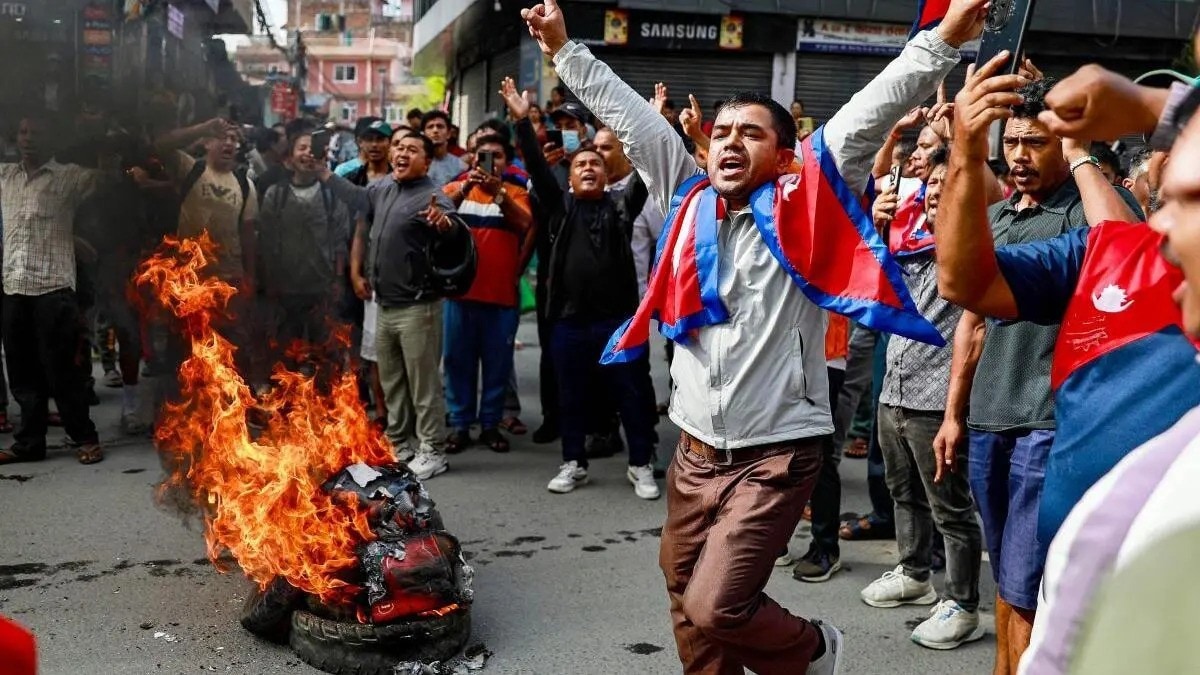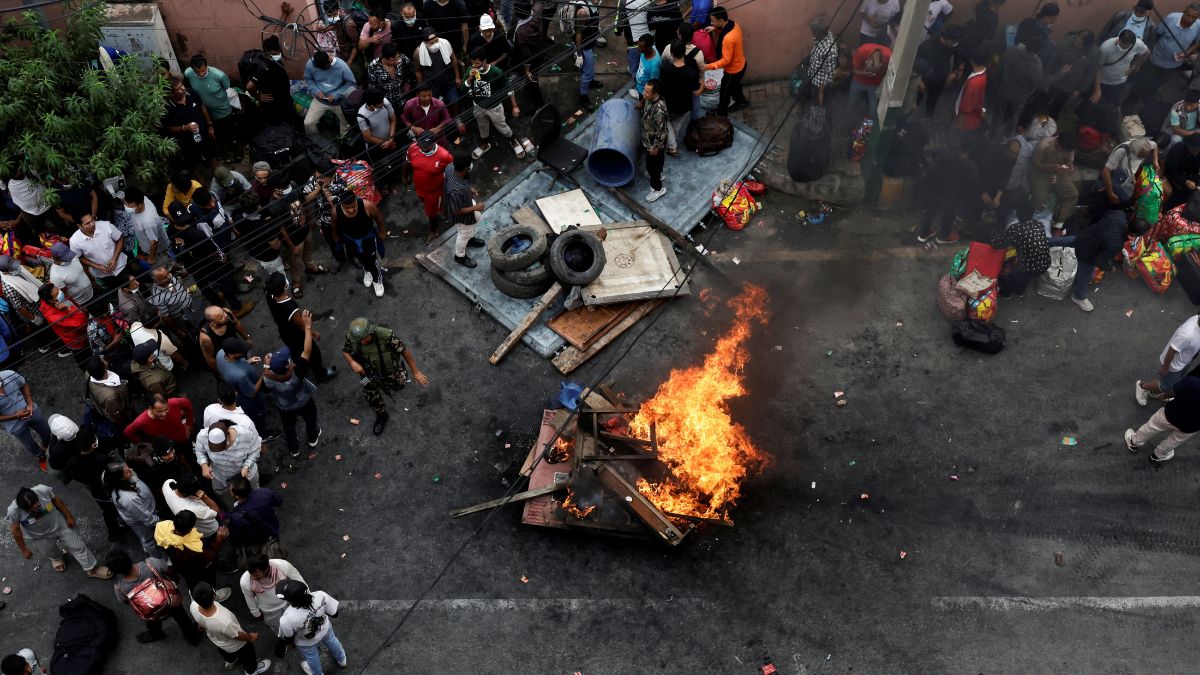Nepotism, corruption, inflation, unemployment, and ineffective governance have cumulatively led to political paralysis in Nepal. Anarchy and lawlessness envelop the Himalayan nation. The Nepali government’s imposition of a social media ban to allegedly mitigate the prolonged simmering tensions and the public angst against misgovernance escalated the conflict, leading to mass protests, torching of the government building, actions from law enforcement agencies, and casualties. Nineteen students lost their lives, which conflagrated the situation beyond conceivable repair. Cycles of disappointment have finally manifested on the streets. The problem seems complex and requires immediate redressal. The Prime Minister K P Sharma Oli’s resignation illustrates political chaos.
Gen Z reaction
The protest that started over the social media ban was a long-awaited trigger that took the shape of a political disaster. The digital-savvy Nepali youth used the social media platform to express their criticism against the poor and pathetic governance. Nepotism was rampant, and disappointment was visible. The Gen Z reaction in the age of social media spiralled into the shape of a revolution. The counter-reactions from the law enforcement led to casualties among the young people. Loans from China and the IMF and remittances from the Nepali diaspora constitute landlocked Nepal’s economy. Increasing unemployment and inflation have encouraged migration of the Nepalis.
Around 2-3 million Nepalis live outside Nepal. The only source of communication with the people in the homeland and overseas is social media, namely WhatsApp and Facebook. The ban on them ensured a communication disconnect. This instantly became the turning point to vent pent-up frustrations against the government. The Gen Z took the lead, and the scale of violence became unprecedented and uncontrollable, leading to the complete collapse of the political order. The political class, in particular, has borne the brunt of the Gen Z revolution.
The anger against the ‘Nepo-kids’ who rise to prominence using their parents’ political elitism and connection, and their flagrant and ostentatious lifestyle and social media show-off, added a convincing reason to Gen Z’s armoury of resentment. The anger is palpable, and emotions run high. The street feels the heat. Smoke billows from the government building in Kathmandu. In the age of social media, the youth are very active and understand its power, scope, and impact. They get a platform to express their views. Nothing remains a secret in the era of social media. Social media is the space of open and democratic journalism, wherein every citizen finds a place to share his/her views. This is a revolutionary technological feat in the first quarter of the twentieth century.
Impact Shorts
More ShortsExperimenting with democracy
The year 2008 marked the end of the monarchy and the formalisation of a federal democratic republic in Nepal. The journey of its democracy has been shaky and weak. Fourteen governments in seventeen years is the story of democracy in Nepal. It has increased political and civic fragility in the country. Communist polity and Maoist thought constituted the core of constitutional democracy in Nepal. This experimentation failed despicably. It led to rampant corruption, foreign interference, authoritarianism, profiteering, sloganeering without development, greed, hunger for power, and rank opportunism, which made democracy a casualty.
In the whirlpool of things, the groundswell for monarchy is increasing. The noise is heard about the restoration of the monarchy. The current political paralysis will definitely pave the way for a political transition. Will it lead to a ragtag political coalition or a confident monarchy with a strong history? Though everything about Nepal’s monarchy in the past was not good, its viability in the face of democratic anarchy cannot be ignored.
In the name of democracy, Nepal has seen the political recycling of a minority of political figures taking convenient turns to rule. The political musical chair in Nepal inflicted casual governance on people without any seriousness towards people’s difficulties. The current crisis is a moment of catharsis for the suffering multitude in Nepal, but the political uncertainty will envelop Nepal. No strong leadership or political blueprint to readjust to the new reality and renewed aspirations may impede the reinstatement of law and order.
The political transition may become sluggish and prolonged. Current political fragmentation in Nepal and general suspicion against all political parties create roadblocks for restoring democracy. It is easy to break a structure but difficult to build one. Demagogy is easy, but developing a rational and workable political system is difficult. The anger on the street needs to be converted to democratic governance. The passion must pave the way for a workable democratic political process instead of deepening the crisis. The former New York Governor Mario Cuomo said, “You campaign in poetry, you govern in prose.”
Script of Regime Change in South Asia
The upheaval in Nepal seems more organic because the people’s anguish against the political establishment and its persistent apathy towards the public has been long simmering. It was in search of a trigger to explode dangerously. Given these concessions, can it be ascertained that there is no foreign interference? Nothing conclusive can be said about it. The suspension needle will be directed at some of the forces making regime changes in South Asia. Bangladesh, Myanmar, and Sri Lanka saw such a violent overthrow of the political establishment. Now, Nepal is the new target.
The pattern is clearly discernible. The framework was applied verbatim. Torching the Supreme Court and Parliament and other acts of arson and vandalism resemble the repeat of Bangladesh and Sri Lanka. There is some method in this madness. Recovery in Bangladesh and Myanmar seems remote. These violent political overthrows in India’s immediate neighbourhood are not a good sign.
Security concerns
India shares an open border with Nepal. India continues the much-cherished tradition of Beti-Roti ka rishta with Nepal. India’s sensitivity towards Nepal is organic. Anarchy in India’s backyard is not good from a security point of view. An unstable neighbourhood is a bottleneck to economic progress. Chronic political instability may lead to a refugee crisis. India will be the natural choice for seeking shelter. Disruptive forces may find the opportunity to mingle with the refugees and enter India to cause problems.
The adversaries of India may weaponise the neighbourhood instability to add more difficulties for India. Donald Trump’s tariff bullying, SCO, BRICS, and restructuring of international order and relations, regime change operation in South Asia, the Russian-Ukraine war, West Asian fragility, etc., make the general international situation more complex. Nepal’s political instability after Sri Lanka, Myanmar, and Bangladesh in quick succession complicates the geopolitics of South Asia.
India’s natural link with Nepal is civilisational. India will put all its efforts into calming down the political chaos, given the vested interests of the interest groups and their intransigence, to keep the turmoil going. Once a workable political order is established, it will help Nepal restore normalcy. Though it is easier said than done, the increasing interests of China and the US in South Asia and their growing rivalries will tense the region. India has to put in its best efforts to ensure security alertness along its borders and mitigate the conflict in Nepal. It is also assumed that the paralysis of India’s periphery is a critical move to checkmate India.
If this happens to be the larger design, India must prepare effectively to address anything that stands contrary to India’s interests. It is known that India’s adversaries also operate in Nepal and use the open border to push their nefarious objectives. The geostrategic importance of South Asia has also been the pivot for interest groups to push a regime change project to make it increasingly unstable. India’s growing strength and political stability have become an eyesore for its adversaries. Given these antecedents, India must save Nepal from crisis and remain alert to possible security concerns.
Dr Jajati K Pattnaik teaches at the Centre for West Asian Studies, School of International Studies, Jawaharlal Nehru University, New Delhi. Dr Chandan K Panda teaches at Rajiv Gandhi University (A Central University), Itanagar. Views expressed are personal and do not necessarily reflect Firstpost’s editorial stance.


)

)
)
)
)
)
)
)
)



